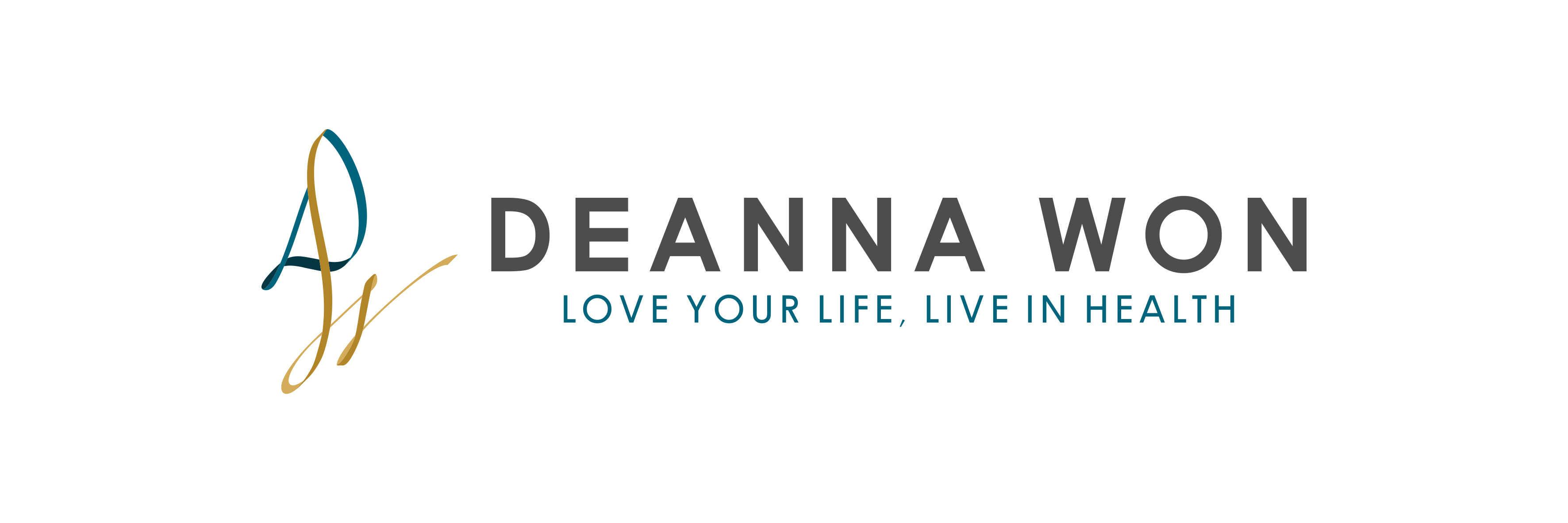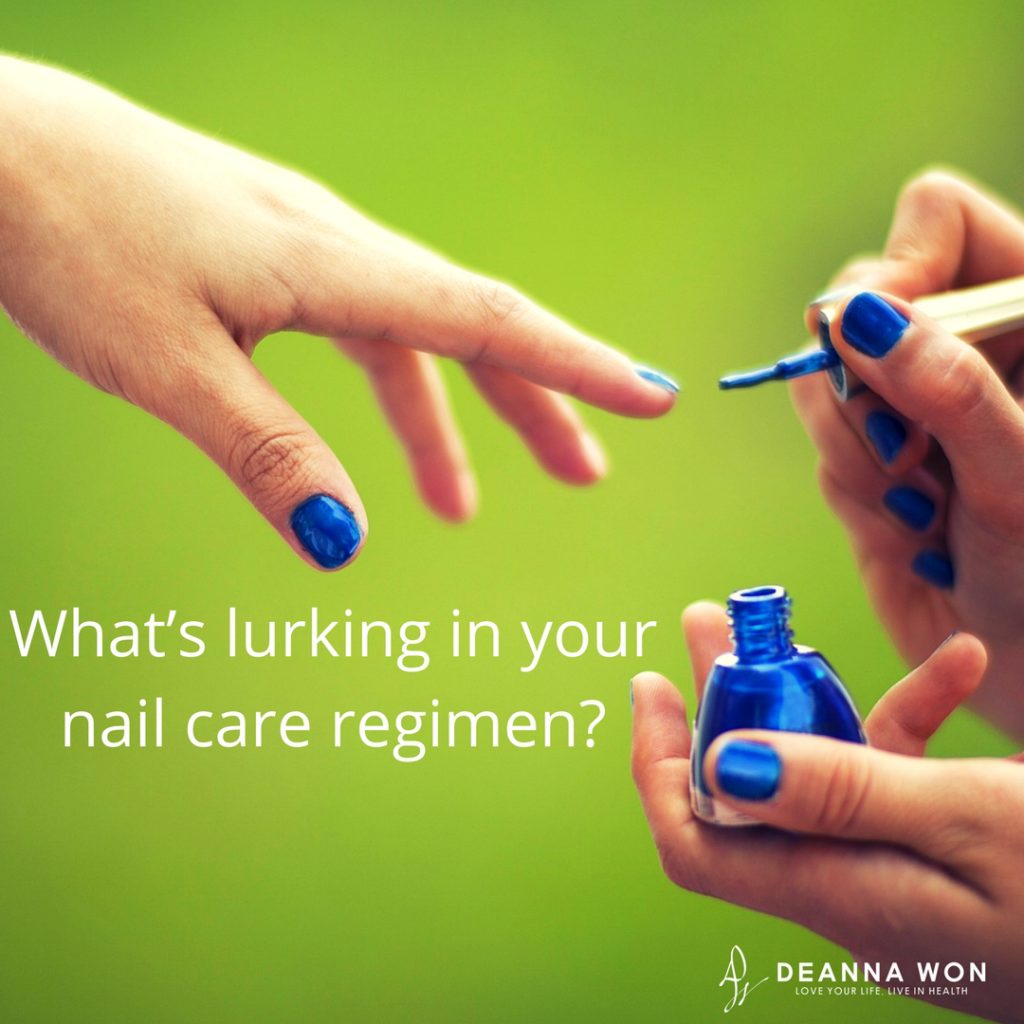You may have heard that your looks are never complete if your nails are not well groomed. When you reach out to shake someone’s hand, sign a document, or wave a greeting, it can seem like a sign of disrespect if your nails are not shaped and polished. With this belief that so many have held on to for years, it’s no wonder that thousands of women make their way to a nail salon each week for a fresh coat of paint, some filing, or to reapply their artificial nails.
Last year, I spoke at an ovarian cancer conference where many of the attendees were cancer survivors. I admired these women as I saw their beauty and strength, especially from all that they had gone through. However, when I saw their polished nails, I couldn’t help but wonder if they were aware of the toxic chemical cocktails they were putting into their bloodstream via their nails?
Our nails are a direct pathway into our bloodstream. Although our nails feel much harder than our skin, they are very porous. Water can pass through our nails much easier than it can through our skin. Knowing this, we should be wary of the chemicals that we allow on our nails. Yet, I’m sure that many of those who frequent nail salons are not well informed of the many chemicals that they are exposing themselves to that may impact their health. In a study by Duke University and the Environmental Working Group, the chemicals found in nail polish can enter the bloodstream within two hours of application.
If you’ve ever walked past a nail salon in a strip mall, you’re probably all too familiar with the very strong odor that wafts out of the door, assaulting both nostrils. Loaded within what you’re smelling are toxins, some of which have been shown to cause headaches, dizziness, nausea, neurological problems, respiratory issues, and even cancer.
Workers in nail salons are exposed to these chemicals for hours a day. They’re inhaling fumes and acrylic powder particles that continually circulate in the air. Some salon workers have experienced chronic nose bleeds, coughs, and breathing problems due to inflammation in the lungs.
In Oakland, California, many Vietnamese women were coming down with respiratory issues. After realizing that many of these women were nail technicians, workers at Asian Health Services decided to conduct their own investigation into the nail industry and, along with the California Healthy Nail Salon Collaborative, pushed to improve standards. Despite their valiant efforts, the cosmetics industry blocked a ban on the chemicals that the initiative stated were toxic for the manicurists.
While many nail salon clients do not have the same type of exposure to these chemicals as salon workers, with each visit, you’re breathing in these chemicals for the duration of your visit. You’re also placing these chemicals directly on your porous nails where they can seep into your bloodstream.
The FDA acknowledges that there are harmful ingredients in nail polish, which, if used as directed, are supposed to be safe. According to a study by Duke University and the EWG, the chemicals used to treat the nails prior to applying nail polish may actually make the nails more permeable, thereby increasing the risk of the chemicals from the nail polish entering the bloodstream.
What are the toxic ingredients we should be avoiding in our nail care?
- Acetone. Found in nail polish remover, acetone can cause headaches, dizziness, and irritation to the eyes, skin, and throat. In studies, acetone has also been shown to cause mood swings, sluggishness, and loss of strength. Regarding acetone as a carcinogen, there is currently no conclusive evidence that acetone is cancer-causing.
- An ingredient in fingernail glue remover, it irritates the nose and throat, causes breathing problems, nausea, vomiting, weakness, and exhaustion. This chemical can also cause fatal cyanide poisoning as it turns into cyanide in the body. Acetonitrile can cause an enlargement of the thyroid, inflammation of the skin, and can affect the liver, lungs, and central nervous system.
- Butyl acetate. This highly flammable ingredient found in nail polish and nail polish remover, can cause headaches and irritation of the eyes, skin, nose, mouth, and throat. If you’re pregnant, it may also potentially harm the developing fetus.
- Dibutyl phthalate is used in plastics to make them more flexible. Many studied phthalates can cause nausea and irritation of the eyes, skin, nose, mouth, and throat. Phthalates have also been linked to asthma, ADHD, breast cancer, obesity, type II diabetes, neurodevelopmental issues, behavioral issues, autism, and reproductive issues in both men and women.
- Ethyl acetate, characterized by its sweet smell, is found in nail polish, nail polish remover, and fingernail glue. Also highly flammable, this colorless chemical can cause irritation to the eyes, stomach, skin, nose, mouth, and throat. At high concentrations, ethyl acetate can also cause fainting.
- Ethyl methacrylate (EMA) is the artificial nail liquid that can cause asthma, irritation of the eyes, skin, nose, and mouth, as well as difficulty concentrating. If pregnant, this chemical can also cause developmental problems for the unborn fetus.
- Formaldehyde. This preservative is found in nail polish and nail hardeners. It can cause breathing difficulty, coughing, asthma-like attacks, wheezing, allergic reactions, irritated eyes, skin, and throat. If these effects were not enough, formaldehyde can also cause cancer.
- Isopropyl acetate, used in nail polish and nail polish remover, can cause sleepiness, and irritation of the eyes, nose, and throat. Repeated exposure may cause bronchitis and damage to the liver.
- Methacrylic acid. This odorous chemical is used in nail primer, and has the capability of causing skin burns and irritation of the eyes, skin, nose, mouth, and throat. At high concentrations, methacrylic acid can cause difficulty breathing.
- Methyl methacrylate (MMA). Though it has been banned in the United States since the 1970s in liquid form, it is still used in powder form in the application of artificial nails. The liquid form has been replaced in nail products with EMA, ethyl methacrylate. Breathing this chemical can cause asthma, irritation of the eyes, skin, nose, and mouth, difficulty concentrating, and the loss of sense of smell. A 2011 study showed that in the three salons examined, all had unsafe levels of this chemical in the air.
- Toluene, a by-product of crude oil can damage the nervous system as well as irritate the eyes, throat and lungs. It can also lead to dry or cracked skin, headaches, dizziness, damage to liver and kidneys, and affect the development of an unborn child during pregnancy. In the 2011 study referenced above, it concluded that workers were exposed to unsafe levels of toluene.
In addition to the chemicals that you breathe and have brushed onto your nails, UV lamps also pose a threat to your health in nail salons. The bulbs used in these lamps are the same bulbs used in tanning beds. UV rays are used to quickly dry nails as well as harden gel manicures. The rays contribute to photoaging the skin, contributing to age spots, wrinkles, and potentially, cancer.
To prevent these harmful effects, the safest option is to avoid nail salons, polishes, and artificial nails at all cost. However, if avoiding nail color is not an option, try finding nail polishes that avoid these toxic chemicals. Please note that not all companies disclose all the chemicals that are used in their products, including those that claim to be toxin-free. Even though these products are regulated by the FDA, they are not regulated at the pre-market stage. Therefore, these items can hit the market before formulations are approved.
If you choose to avoid polishes altogether, you can continue to shape yours nails, keep your cuticles pushed back, and your nails conditioned with coconut oil. If your nails are yellowed from prolonged use of nail polish, you can whiten the tips by soaking them for five minutes in lemon juice, using the juice of half a lemon, and a cup of warm water. If you need a bit more of an exfoliant for your nails, mix a few teaspoons of water with an equal amount of baking soda. Add approximately ten drops of lemon juice, allow the solution to bubble, and soak for ten minutes. When done, use a toothbrush to brush your nails with the solution, then rinse. Follow up with either coconut or olive oil to moisturize.
You don’t have to sacrifice nail care for good health. Find healthy alternatives that are toxin-free, such as the lemon juice method, that can keep your nails looking well kept. With increasing awareness of the toxins in the nail care industry, it is likely that safer, healthier options are right around the corner. Be sure to do your research on what you’re placing on your nails. You can still look great while taking care of your health. Remember, you’re worth it.
Ready to make your health a priority? Contact me here to schedule your consultation.
Sources:
https://www.scientificamerican.com/article/these-4-chemicals-may-pose-the-most-risk-for-nail-salon-workers/
https://www.msdsonline.com/blog/compliance-education/2013/05/06/12-of-the-most-hazardous-chemicals-you%E2%80%99ll-find-at-a-nail-salon
http://health.howstuffworks.com/skin-care/nail-care/tips/chemicals-used-at-nail-salons-bad.htm
http://www.huffingtonpost.com/entry/nail-polish-chemicals-entering-the-body_us_5627e311e4b02f6a900f59c7
http://www.foxcarolina.com/story/28958453/doctor-warns-of-potential-dangers-from-using-gel-nail-polish
https://www.des.nh.gov/organization/commissioner/pip/factsheets/ard/documents/ard-ehp-7.pdf
https://dailyhealthpost.com/toxic-nail-polish-and-natural-alternatives/
https://www.cancer.org/cancer/cancer-causes/formaldehyde.html
https://www.michigan.gov/documents/MDCH_Acetonitrile_fact_sheet_approved_4-19-05_122749_7.pdf
http://nj.gov/health/eoh/rtkweb/documents/fs/1329.pdf
https://www.nytimes.com/2015/05/11/nyregion/nail-salon-workers-in-nyc-face-hazardous-chemicals.html
https://www.michigan.gov/documents/MDCH_Acetonitrile_fact_sheet_approved_4-19-05_122749_7.pdf
https://www.theguardian.com/lifeandstyle/2015/feb/10/phthalates-plastics-chemicals-research-analysis
https://www.msdsonline.com/blog/health-safety/2015/04/10/ethyl-acetate-a-sweet-smelling-safety-hazard
http://www.nj.gov/health/eoh/rtkweb/documents/fs/1074.pdf
https://www.cdc.gov/niosh/ipcsneng/neng0917.html
https://nsinails.com/blog/2016/07/15/why-is-mma-suitable-for-use-in-nail-powder-polymer-and-not-suitable-for-use-in-nail-liquid-monomer/
https://dailyhealthpost.com/toxic-nail-polish-and-natural-alternatives/
http://www.huffingtonpost.com/entry/nail-polish-chemicals-entering-the-body_us_5627e311e4b02f6a900f59c7

